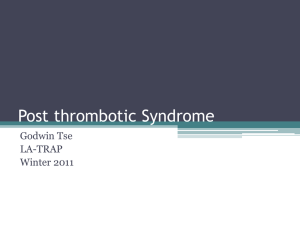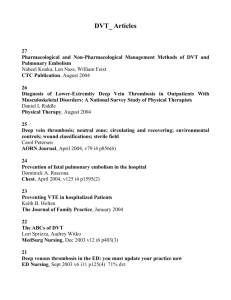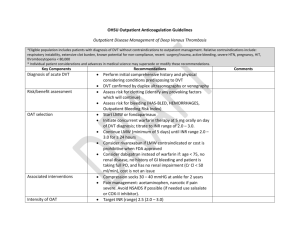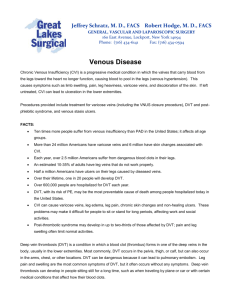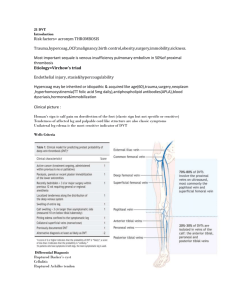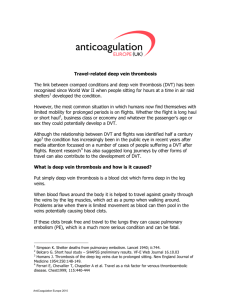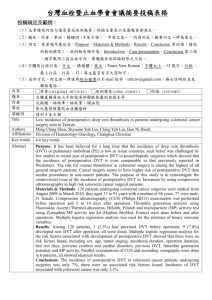Slide - Society Of Interventional Radiology
advertisement
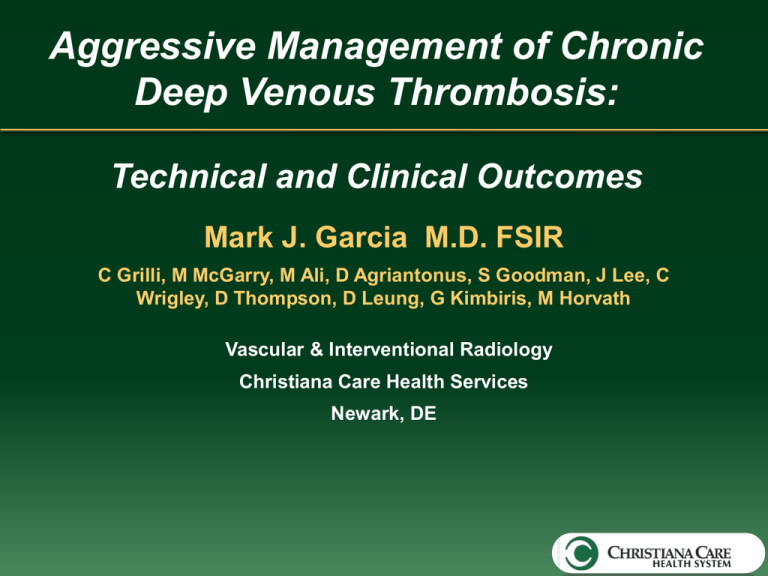
Aggressive Management of Chronic Deep Venous Thrombosis: Technical and Clinical Outcomes Mark J. Garcia M.D. FSIR C Grilli, M McGarry, M Ali, D Agriantonus, S Goodman, J Lee, C Wrigley, D Thompson, D Leung, G Kimbiris, M Horvath Vascular & Interventional Radiology Christiana Care Health Services Newark, DE Background Deep venous thrombosis (DVT) - 500,000-600,000 new cases in US annually1 - 40-60% of pts on anticoagulation will develop PTS after 1st episode of DVT2 Post thrombotic syndrome (PTS) - clinical complication of DVT can be lifestyle limiting and debilitating - Sx: pain, edema, varicosities, skin discoloration, thickening & ulceration - 500,000-600,000 venous ulcers yearly3 Estimated socioeconomic burden of $ 3 billion annually4 Background Standard tx of anticoagulation: elastic compression stockings (ECS) …….. often not sufficient Purpose Evaluate the safety and efficacy of treating pts with chronic DVT & PTS Report early & midterm results on patency & symptomatic improvement Demographics Retrospective, single center case reviews 106 patients and 122 limbs treated - 66 M, 40 F Mean age 57; range 13-96 years old 17 upper and 105 lower extremities IVC involvement in 25 (24%) Documented DVT by US All patients had symptoms > 1mo DVT defined as chronic by age of sx onset > 1mo All with varying degrees of PTS symptoms: - Pain & swelling ulcer & gangrene ( > CEAP 3) - All c/o lifestyle limitations Methods Case review data was collected including: - DVT history Procedural information Immediate technical outcomes Symptomatic improvement Ultrasound follow-up at 1,3,6, and 12 months, and yearly thereafter Methods Minimally Invasive endovascular techniques included: - Initial PTA Lysis +/- US assisted (EKOS) PCBs Adjunctive therapies Stenting, PMT - Anticoagulation - ECS Tests your skills…. Results Technical success defined as: A) Ability to cross vein occlusion 120/122 98% B) Ability to restore flow 118/122 97% Results Clinical success defined as: 1. Symptomatic improvement 2. US Patency (persistent flow) Results Symptomatic Improvement Mean follow-up: 2 yrs 7 mo 104 of 122 limbs: - 97 (93%) reported significant improvement - 7 (7%) unchanged - 0 worse - 18 were lost to follow-up 100 93 Significant Improvement 80 Unchanged 60 Worse 40 20 0 7 0 Results US Patency ( % Remaining open) Patent Limbs (%) 1 mo: 95 of 100 (95%) 3 mos: 71of 77 (92%) 6 mos: 57 of 65 (88%) 12 mos: 30 of 38 (79%) 24 mos: 11 of 19 (58%) 100 95 92 88 80 79 58 60 40 20 0 1 3 6 12 24 Example • 65 yo F in 1998 had hysterectomy w/ left iliac vein rupture. • Vasc surgeon unable to repair- ligated • Immediately developed pain & swelling • Extensive LLE DVT • Anticoagulation & ECS x yrs • Severe limitations in activity with poor QOL • Referred by VS for eval & management 12 yr old DVT Post Treatment 12 Mo. F/U US 18 Mo. F/U “Extremely happy” w/ result. Active w/ daily treadmill & cycling Rare & minimal swelling No pain Rx w/ therapeutic anticoagulation x 2 yrs ECS daily Conclusion Chronic, occlusive DVT causing significant quality of life limitations from PTS can safely and effectively be treated with excellent short to mid term technical and clinical outcomes. Further larger, multi-center, controlled trials would be warranted. Imagine Thank You magarcia@christianacare.org 302-733-5625 References 1. US surgeon general’s office; 2008. 2. Kahn SR, Shrier I, Julian JA, et al. Determinants and time course of the post-thrombotic syndrome after acute deep venous thrombosis. Ann Intern Med 2008;149:698–707. 3. Pacific Vascular Symposium 6. Kona, Hawaii, 2009. 4. Lazarusetal. Arch Dermotolgy 1994; 130:489-93.
